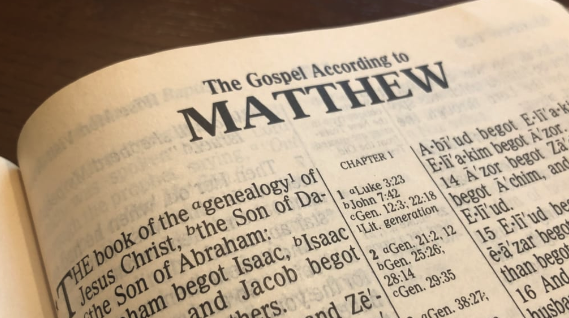“For the Son of Man is going to come in the glory of His Father with His angels; and WILL THEN RECOMPENSE EVERY MAN ACCORDING TO HIS DEEDS.
Debates continue over which biblical passages refer to the AD 70 judgment coming of Jesus and those that refer to what is commonly called a yet physical Second Coming of Jesus. As I have pointed out, there is no agreement among scholars on this question, especially among those who signed the “Three Questions Letter” sent to me to affirm or else! Kenneth Gentry argues that Matthew 16:27 and 28 describe two comings separated by nearly 2000 years (so far). Here’s how he expresses his position:
As an orthodox preterist, I hold that this passage brings together the AD 70 judgment and the Final Judgment. As orthodox preterists argue (following most conservative, evangelical theologians in general), the AD 70 destruction of the temple is a dramatic judgment of God in itself. But it is also a typological foretaste of the universal Final Judgment, which it pictures through the local judgment on Israel. (This is much like the Israel’s Old Testament exodus event being an important act in itself, while serving as a type of coming redemption through Christ.)
Gentry shows by his comment that there is no unanimity on the claim that two comings are found in the two verses. Yes, many evangelical commentators believe Matthew 16:27 is a Second Coming passage. Surprisingly, he states, “Many scholars see v. 28 as simply repeating v. 27, using different words.” This means that “many scholars” disagree with Gentry that two comings are described in verses 27 and 28. While he does not tell us who these “many scholars” are, I’ll list some of them. There’s this from Adam Clarke (1762-1832):

John Lightfoot (1602-1675) also disagrees with Gentry. The following is from Lightfoot’s comment in the parallel account in Mark 9:1: “his coming in glory should be in the lifetime of some that stood there.”[1]
Henry Hammond (1605-1660) has this to say on Matthew 16:27:
[v. 27] For there shall be a solemn visitation among the Jews, a time of judgment on them … wherein there shall be a visible discrimination between those which cleave fast to Christ, and those which do not, and so likewise on all mankind, either in particular visitation upon kingdoms, or at the day of doom. [v. 28] And of this coming of mine against my enemies, and to the relieving of them that adhere to me, I tell you assuredly, that some that are here perfect, John by name [John 21:], shall live to see it, that is, that he shall not die till that remarkable coming of Christ in judgment upon his crucifiers, the visible destruction of the Jewish S[t]ate.
Several commentators have taken the approach that Jesus predicted that His coming was near, but He was wrong. For example, Frederick Dale Bruner states that “Jesus’ expectation of the time of judgment of ‘every’ person is soon: ‘The Son of Man is just about (mellei, placed at the head of the sentence for emphasis … to come. We now know that this expectation, in its earliest and strict sense, was mistaken: the Son of Man did not come just then in the glory of his angels for judgment.”[2] This is an untenable and illogical position to take, especially by commentators who believe Matthew’s gospel was written after AD 70. Why leave this “mistake” in a gospel?[3]

Wars and Rumors of Wars
A first-century interpretation of the Olivet Discourse was once common in commentaries and narrative-style books that describe the fall of Jerusalem in AD 70. There is also a history of skeptics who turn to Bible prophecy and claim Jesus was wrong about the timing of His coming at “the end of the age” and the signs associated with it.
Buy NowAccording to Gentry, the parousia in Matthew 24:27 refer to the Second Coming and not the coming of Jesus in judgment in AD 70. Here’s what he wrote in 1999 in his published debate with Thomas Ice: “Jesus warns His followers that He will not appear bodily in the first-century judgment (vv. 23, 25-26). Nevertheless, He will ‘come’ in judgment like a destructive lightning bolt against Jerusalem (v. 27). This coming, however, is a providential judgment coming, a Christ-directed, rather than a miraculous, visible, bodily coming.”[4] Gentry changed his position in his 2010 book The Olivet Discourse Made Easy.[5] He now argues that Matthew 24:27 refers to the Second Coming. But other partial preterist commentators disagree. For example, John Gill who states that Matthew 24:27 “must be understood not of his last coming to judgment … but of his coming in his wrath and vengeance to destroy that people, their nation, city, and temple.”
Adam Clarke also interprets Matthew 24:3 and 27 as a reference to AD 70: “What shall be the sign of thy coming [parousia]? viz. to execute these judgments upon them [the destruction of the city, temple, and Jewish state]…. It is worthy of remark that our Lord, in the most particular manner, points out the very march of the Roman army: they entered into Judea on the EAST, and carried on their conquest WESTWARD, as if not only the extensiveness of the ruin, but the very route which the army would take, were intended in the comparison of the lightning issuing from the east, and shining to the west.”
“In v. 27 the coming is indeterminate, simply stating that ‘the Son of Man is going to come.’ Here mellō (‘be destined to’) is followed by the present infinitive erchomai (‘come’).’ This results in the statement meaning that he ‘will certainly come.’ But it provides no indication of when that might be.”[6]
If this is true, then no one can be dogmatic about applying Matthew 16:27 to the Final Judgment/Second Coming since Jesus could have “certainly come” before that generation passed away. John Lightfoot disagrees with Gentry on the timing in his comment on the parallel, passage in Mark 9:1: “his coming in glory should be in the lifetime of some that stood there.”[7]
“‘His words are generally so interpreted (of His personal visible return), and this seems at first their obvious meaning. Yet it is doubtful whether all the language which is so interpreted is not better understood as oriental imagery describing the accompaniments of His coming in the conversion of multitudes to faith in Him, and in the downfall of Judaism as the representative of true religion’ (Burton and Matthews).”[8]
Jesus said the following at His trial before Caiaphas and others in attendance: “‘But I tell you [plural], from now on you [plural] will see the Son of Man seated at the right hand of Power and coming on the clouds of heaven’” (Matt. 26:64).
Milton Terry offers the following commentary on the parallel accounts:
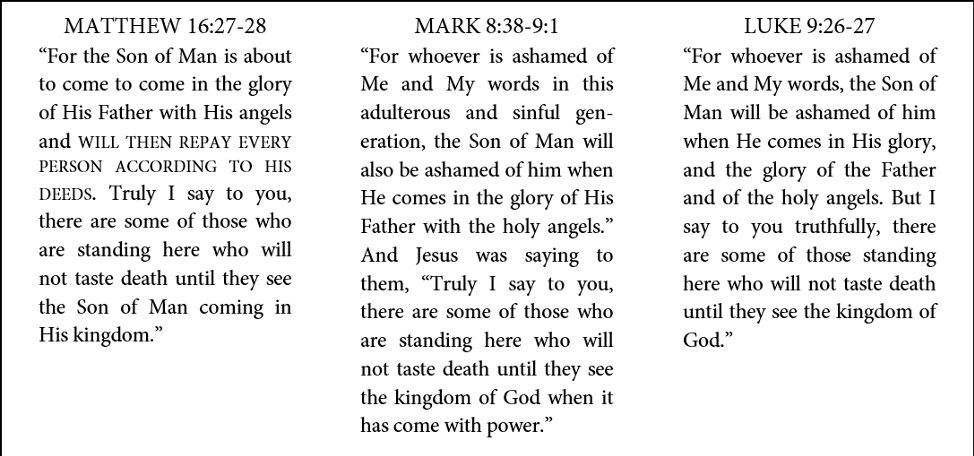
All sorts of efforts have been made to evade the simple meaning of these words but they all spring from the dogmatic prepossession that the coming of the Son of man in his glory must needs be an event far future from the time when the words were spoken. Some have understood that the reference is to the transfiguration which all three synoptists record immediately afterward. But two decisive objections stand in the way of such a reference: (1) that event occurred only six or eight days afterward, and (2) it could not with any propriety be called a coming of the Son of man in the glory of his Father with the angels, or coming in his kingdom. Others have distinguished between Christ’s coming in the glory of his Father with the angels and his coming in his kingdom or the coming of his kingdom. But we incline to the belief that very few can be fully persuaded, with the above Gospel-parallels before them, that our Lord meant to be understood as speaking of two events centuries apart. Had this been his intention he might certainly have employed language less ambiguous and less likely to confuse the minds of his disciples. The plain teaching of the passage is that before some of those who heard him speak should die the Son of man would come in glory, and his kingdom would be established in power. And this teaching is in strict accord with what is taught in Matt xxiv and its parallels in Mark and Luke.[9]
Not everyone would agree with Gentry’s interpretation of mellō in Matthew 16:27. For example, in Gnomon Novi Testamenti, or Exegetical Annotations on the New Testament, published in 1742, Johann Albrecht Bengel states, “μέλλει ἔρχεσθαι should be translationed “is about to come, … a stronger expression than ἐλεύσεται will come.” Alexander B. Bruce, in his commentary on the Gospels in The Expositors Greek Testament series, concludes that “μέλλει points to something near and certain; note the emphatic position” (1:227). Davies and Allison’s commentary on Matthew in the International Critical Commentary series comment, “Our evangelist has also added (in anticipation of v. 28; …) μέλλει…. Although μέλλω need not imply imminence … more often than not it does in the First Gospel (2:13; 17:12, 22; 24:6). That nearness is intended in 16:27, where the verb is editorial, is strongly suggested by what follows, v. 28, which is an assertion about the Son of man coming in the near future…. In fact, v. 28 can be viewed as explicating the μέλλει of v. 27.”[10]
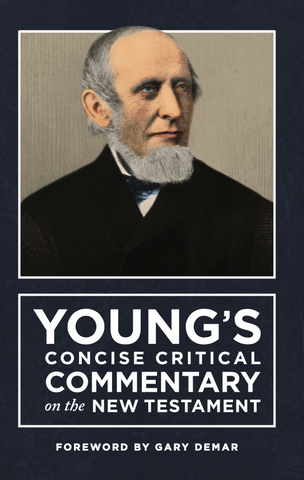
Young's Concise Commentary on the NT
A concordance lists most every word in the Bible and gives its English translation. A concordance like Strong’s Exhaustive Concordance also serves as a basic Bible dictionary. Strong’s comes in printed and electronic forms. It is keyed to the KJV. This is why a literal translation of the Bible is helpful. In addition to his Analytical Concordance to the Bible—where the original Hebrew or Greek words are listed as well as the pronunciation—Robert Young (1822-1888) also published several editions of his Literal Translation of the Bible (YLT). He also published the Concise Critical Bible Commentary that was "Specially Designed for Those Teaching the Word of God."
Buy NowThere is evidence of commentators applying 16:27-28 to that Apostolic generation, for example Sylvanus Cobb:
“These two verses conclude the course of conversation which Jesus, at that sitting, held with his disciples. He here re-affirmed the certainty of that judgment of which he had repeatedly spoken to them, and also to his enemies, before,—and to which he referred at verse 25. And he expressly affirmed that this judgment should come during the lifetime of some of his hearers. Of course he spoke of the judgment which involved the dissolution of the Jewish church and state.…The assumption that what is meant in these verses by the Son of man coming in the glory of his Father, and in his kingdom, referred to the transfiguration noted in the beginning of the next chapter, is a species of trifling with the Scriptures hardly worthy of notice.… All these events,—the fulfillment of Jesus’ prophecies, the visible manifestation of God’s providence in behalf of his cause and church, and the dissolution of the power of that people who were, directly, and indirectly by instigating the Gentiles, his chief persecutors, involved a more extensive and permanent establishment of his cause and kingdom in the world. Though, in a sense, the Christian dispensation may be said to have commenced when Christ entered upon his public ministry, yet there was a lapping, as it were, of the two dispensations. Visibly and historically, the Christian age commenced when it supplanted the Jewish age, on the dissolution of the Jewish polity. This was, in an eminent New Testament sense, the coming of the Son of man in his kingdom.”[11]
Robert Young comments: 27. SHALL COME,] lit. ‘is about to come,’ in 40 years.
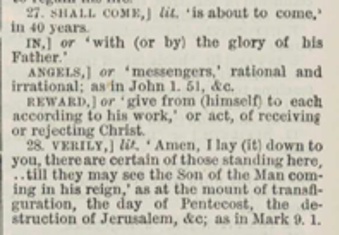
Zachary Pearce (1690-1774) on Matthew 16:25, 27-28.[12]
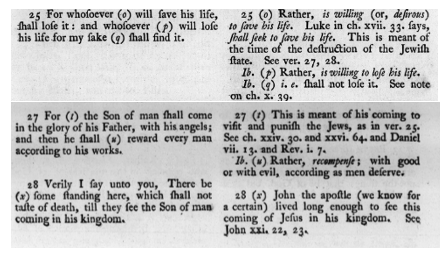
James Stuart Russell has a lengthy discussion on Matthew 16:27-28 in his book The Parousia (32-33):
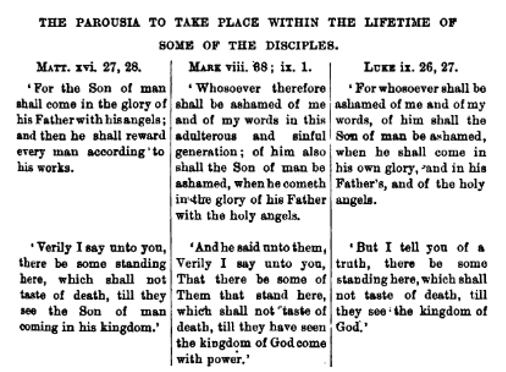
“[T]he coming here spoken of is the Parousia, the second coming of the Lord Jesus Christ…. His coming was to be glorious—‘in his own glory;’ ‘in the glory of his Father;’ ‘with the holy angels.’ … the object of His coming was to judge that ‘wicked and adulterous generation’ (Mark 8:38), and ‘to reward every man according to his works.’… His coming would be the consummation of ‘the kingdom of God;’ the close of the æon; ‘the coming of the kingdom of God with power.’… this coming was expressly declared by our Saviour to be near. Lange justly remarks that the words, μέλλει γὰρ, are ‘emphatically placed at the beginning of the sentence; not a simple future, but meaning, The event is impending that He shall come; He is about to come.’[See Lange in loc.]…The inference therefore is, that the Parousia, or glorious coming of Christ, was declared by Himself to fall within the limits of the then existing generation,—a conclusion which we shall find in the sequel to be abundantly justified.”
As the above comments show, Gentry’s commentary argument does not hold water. There are many fine commentators who interpret Matthew 16:27 as an indicator of an “about to” coming that’s linked with 16:28. Albert Pigeon’s 11-page list of commentators on how they translate and interpret mellō shows that there is a diversity of opinion on the interpretation of Matthew 16:27. There is a comprehensive study of this topic in Andrew Perriman’s book The Coming of the Son of Man: New Testament Eschatology for an Emerging Church (2005). Based this and other studies, Matthew 16:27 is not a solid argument against full preterism.
[1] John Lightfoot, A Commentary on the New Testament from the Talmud and Hebraica: Matthew—1 Corinthians, 4 vols. (Peabody, MA: Hendrickson Publishers, [1859] 1989), 3:422.
[2] Matthew, A Commentary, 2 vols. (Dallas, TX: Word Publishing, 1990), 2:596. Bruner spends a great deal of time on this claim in his book The Christbook (1987) and on Matthew 16:28 and Matthew 24:34 in his Matthew commentary. I’ve ordered his revised edition of his Matthew Commentary.
[3] A few commentors argue that “mistakes” make the gospel accounts more “authentic.” Craig Keener is an example of this claim in his A Commentary on the Gospel of Matthew (Grand Rapids, MI: Eerdmans, 1999), 435.
[4] Gentry spends nearly two pages making this argument in The Great Tribulation: Past or Future? (Grand Rapids, MI: Kregel Publications, 1999), 53-55. He made a similar argument in his book Perilous Times: A Study in Eschatological Evil (1999).
[5] (Draper, VA: Apologetics Group Media, 2010), 102 and note 27.
[6] “Matt. 16:27-28: AD 70 and the Final Judgment” (July 31, 2018): https://postmillennialworldview.com/2018/07/31/matthew-1627-28-ad-70-and-final-judgment-1/
[7] John Lightfoot, A Commentary on the New Testament from the Talmud and Hebraica: Matthew—1 Corinthians, 4 vols. (Peabody, MA: Hendrickson Publishers, [1859] 1989), 3:422.
[8] Plummer, Alfred — An Exegetical Com. on the Gospel According to St. Matthew, p.237, n.2
[9] Milton Terry, Biblical Apocalyptics: A Study of the Most Notable Revelations of God and of Christ (New York: Eaton & Mains, 1898), 221.
[10] W. D. Davies and Dale C. Allison, Matthew (T&T Clark, 1991), 2:675.
[11] The New Testament of Our Lord and Saviour Jesus Christ; with Explanatory Notes and Practical Observations (Boston: 1864), 48.
[12] A Commentary, with Notes, on the Four Evangelists and the Acts of the Apostles; Together with a New Translation of St. Paul’s First Epistle to the Corinthians, With a Paraphrase and Notes. … Published from the original manuscripts, by John Derby, … In two volumes. … 1777: Vol. 1:117-118.

